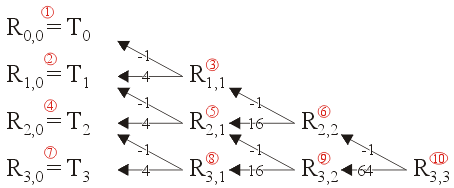Problem
Given a function of one variable, f(x), find the integral on the interval
Assumptions
We will assume that the function f(x) is sufficiently differentiable.
Tools
We will use sampling, iteration, and the composite-trapezoidal rule. Let Tn be the approximation of the above integral using the composite-trapezoidal rule with 2n subintervals.
Initial Requirements
Let R0, 0 = T0.
Iteration Process
Having calculated Rn, 0, Rn, 1, ..., Rn, n, proceed as follows:
Set Rn + 1, 0 = Tn + 1.
Next, for j = 1, ..., n + 1, calculate
For example, Figure 1 shows the order (the circled red numbers) in which the entries Ri, j are calculated. The numbers in the first column are calculated using the composite-trapezoidal rule. For the other entries, the numbers on the arrows indicate the coefficients of the weighted average used to create that entry. This denominator of the weighted average is the sum of the two numbers.

Figure 1. Calculating the Romberg approximations.
Halting Conditions
There are two conditions which may cause the iteration process to halt:
- We halt if the step between successive iterates is sufficiently small, that is, |Rn + 1, n + 1 - Rn, n| < εstep, and
- If we have iterated some maximum number of times, say N, and have not met Condition 1, we halt and indicate that a solution was not found.
If we halt due to Condition 1, we state that Rn + 1, n + 1 is our approximation to the integral.
If we halt due to Condition 2, we state that a solution may not exist.
Copyright ©2005 by Douglas Wilhelm Harder. All rights reserved.


